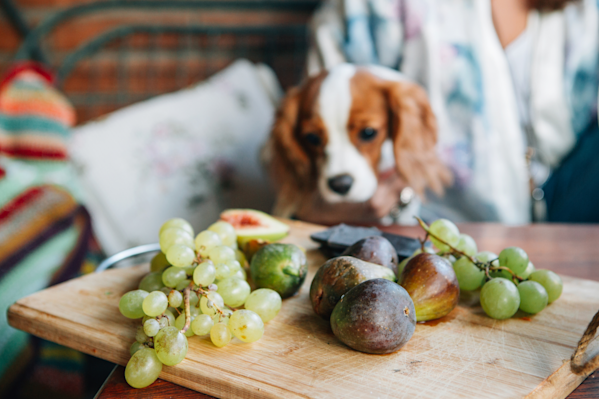Pups love their snacks, and as much as we tell them certain foods are off limits, that’s not always going to discourage them from trying to get a taste.
While many of us know that dogs can’t have grapes, or things made with grapes, some of us don’t actually know why that is. What are the risks of grapes and how do we know when we have a problem?
Why are grapes toxic to dogs?
We want our dogs to have healthy treats, and it's true that some fruits and vegetables are okay to feed them. It's dangerous to make assumptions, though, because there are some that can be quite toxic.
Grapes fall into that category, as do raisins, currants (smaller dried grapes), and sultanas (dried white grapes). These are ingredients that should never be offered, whether raw, cooked, dried, or baked. Watch out for fruit cakes, trail mixes, granola bars, and similar foods which will often contain some form of dried grape. Wine is also dangerous and care should be taken to avoid an accidental sip from your glass or even some spilled on the floor.
It's not yet fully understood why grapes are toxic to dogs and why some dogs can eat grapes without issue while others will suffer fatal consequences. Though it's thought that there could be a genetic component, the individual sensitivity of this food has puzzled experts for decades. Some believe that it's the tartaric acid or mycotoxin in the grape that causes the toxicity.
Ultimately, why even take the chance? Assume that grapes are off limits for all dogs, in all circumstances. It’s much safer that way and a lot better than the alternative.
How many grapes are toxic to dogs?
There is no exact quantity that results in toxicity to dogs, but generally, the larger the quantity, the more likelihood of toxicity. Considering that dogs react differently to grape toxicity, no amount of grapes/raisins/currants can be considered “safe”.
A dog’s weight can factor in, but is not necessarily a determinant. When deciding if you need to seek emergency intervention and you know exactly how many grapes have been ingested, you can calculate that anything more than 1 grape (not raisin) per 10 pounds of body weight should be treated as an emergency.
Did your dog eat a toxic amount of grapes?
Any amount of grapes can end up being toxic to a dog, and the toxicity can lead to sudden kidney failure or even death. While this is not the case for all dogs, it’s impossible to know which dogs will be most affected, so there’s no reason, even in small quantities, that it should be used as a treat. Grapes should be considered off limits for all dogs no matter their size or if they have had them before and haven’t had any issues.
What are the signs your dog ate a grape?
Sometimes, our pets get into food without us even knowing. Especially if a child has dropped food on the floor or given them grapes without understanding the dangers.
If your dog ate a grape, vomiting and/or diarrhea may start, and it will likely happen fast. This could be within a few hours of ingesting grapes, however, your dog may not show symptoms for another 24-48 hours.
In the initial stages of toxicity, you may also notice an increase in drinking and urination, followed by a decrease in urination due to the impact on the kidneys along with a loss of appetite, lethargy, and dehydration. This can be a sign of kidney failure, so it's important to contact a veterinarian immediately if you suspect your dog ate a grape.
How to treat a dog when they eat a grape
If you suspect your dog has had access to grapes or similar fruits and may have eaten some, they need to see a vet immediately. It is recommended to contact animal poison control to report the toxicity so they may advise you and your veterinarian on the level of toxicity.
Sadly, any sort of delay to see if the problem passes may make it too late. At that point, the veterinarian��’s chief goal will be to try to minimize damage by blocking absorption of the toxins and reducing damage to the kidneys if at all possible. This could involve treatments such as activated charcoal, inducing vomiting, and administering intravenous fluids.
This treatment may continue within the hospital for several days and the veterinarian will monitor the dog’s kidney function with blood and urine tests. Ultimately, time is of the essence and the sooner treatment commences, the better the prognosis.
The reality is, we can’t be too cautious when our fur babies are involved. Never underestimate your dog’s ability to eat tasty food.
Preventing your dog from eating grapes and raisins is best. It’s a lot easier to avoid grapes or raisins from being eaten than to deal with the potentially devastating fall out if the eating has already happened. But if something does happen, contacting a veterinarian immediately is of the utmost importance.

Reviewed and fact-checked by
Mika, RVT at Pawp
